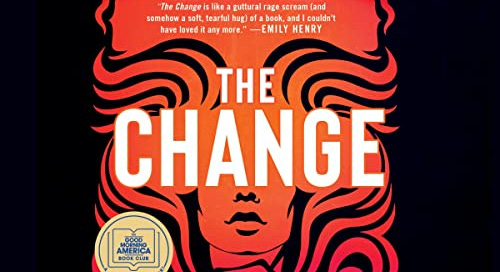The Change is a suspenseful thriller about three women who discover that menopause has granted them supernatural powers. Nessa hears the voices of the dead calling out for peace. Jo generates a heat, first experienced during hot flashes, that manifests itself in a fireball between her hands; soon, she’s melting plastic and burning flesh. Harriett discovers that she can make any plant, healing or deadly, burst from the soil. An unlikely trio, the three women find the dead body of a teenage girl and go on a mission to discover her identity, bring closure to her loved ones, protect others from the same fate, and take revenge on the perpetrator of the crime. It’s immediately clear that this girl is not the only victim to die violently. What they find out about their own community shocks them and puts their lives in danger.
The novel often outright states themes around feminist outrage caused by society’s deep-rooted misogyny, but rage is absolutely the heart of this story. There is no way to overstate the horrific treatment women experience. These three women have been confronted with misogyny over and over again throughout their lives, and they’re only now beginning to recognize it for the poison that it is. Fury that has built up over years of denial drives their actions, fueled by not-so-subtle hints that they should disappear as fertility wanes. I see the repetition of these themes as a deliberate choice—Nessa, Jo, and Harriett have every right to rant and rave.
Underneath those rage-fueled rants, there’s another theme around where women can find refuge. Often, that’s with each other, as they’re able to openly discuss what’s happening without being second-guessed. Women who seem to be well outside our core group find solace in having someone listen to them and believe their stories. The main characters are explicitly driven by a need to protect younger generations from experiencing the kind of violence they see everywhere. It’s no coincidence that Jo and Nessa have daughters, and that Harriett becomes close to Jo’s young child. Each character goes about creating a safe space for women in her own way.
My favorite imagery in the novel lies in Harriett’s garden. This setting appears early on, as neighbors become outraged when a formerly manicured lawn becomes untamed and overgrown. For many, this represents Harriett “letting herself go.” As she transforms into the town witch, she realizes just how little she owes other people. She unapologetically grows a thicket around her property that’s nearly impossible to penetrate for unwelcome visitors. In her garden, we witness both the strength of Harriett’s boundaries and the extent to which she’s willing to go to keep her independence. As her knowledge of plants expands, we see how far she’ll go to help those who seek it or to exact vengeance on those who deserve it.
The men in this novel aren’t all evil, although they do generally need to be clued in on what’s happening in the world around them. Franklin, a police detective from Nessa’s past, is gentle, kind, and patient. But he wants to work only within the law, and that system simply fails women. Jo’s husband is another great example of this—in the beginning of the novel, he’s “working from home,” but neither works on his writing nor takes care of the house. As she spends more time solving the mystery of the murdered girls, he not only begins to step up, but he finds that he can access his creativity again. Both men struggle to free themselves from patriarchy and, in the process, become a breath of fresh air for the reader and the characters.
As everyone’s awareness of these problems grows, they also become aware of their privilege. The story depends on each woman having money, enough to take huge risks and spend a lot of time solving the mystery. What Miller is getting at here is that it takes an enormous amount of privilege in order to actively confront misogyny, however obvious it may be. It’s also clear that the wealthy have a responsibility to look straight at these problems and help women who can’t afford to help themselves. Girls are vulnerable when their families depend on them, when they need money for school, when they engage in sex work. People are ready to exploit that vulnerability, and it takes ongoing work to “root out” even the worst and most obvious perpetrators.
I’ve seen the novel described as a “revenge fantasy,” which is an accurate characterization, I suppose, but this seems to diminish the power of the message here. It’s not just about taking revenge on Bad Men—it’s about claiming power. The newfound magical power stands in for the self-confidence these women earn by embracing middle age. They see the bias all around them and respond by taking up more space.
This isn’t a perfect novel, but my enjoyment overcame my reservations. Until I realized that Miller was repeating herself on purpose, I didn’t quite understand why characters kept simply stating the main themes. I saw a couple of the plot twists coming. But as I kept reading, I found that I couldn’t put it down. These are important themes and compelling plot twists! It’s gratifying to witness these women embrace their power and this new phase in their lives. In a world that can barely discuss menopause, let alone celebrate three protagonists who gain power from it, this representation matters. Read The Change because it’s a fun thriller, but also make sure to show the world that people want to read stories and characters like these.




